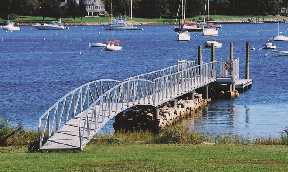If you have ever dreamed of building a dock or wanted to license an existing dock on your waterfront property but felt overwhelmed at the prospect of dealing with the red tape, you are not alone. Many people have started the process but became discouraged with all the different agencies involved in the permitting process. A registered professional engineer familiar with dock design and permitting could be your solution!
A dock facility provides many benefits to the owner as well as the environment. A well planned and constructed dock can last for years, creating a corridor for access to the water, while protecting the delicate ecosystem.
A dock can be a relatively simple structure, usually including a raised walkway, support pilings, a ramp, and some form of float system. Most docks are constructed using pressure treated wood. New products, such as synthetic decking, made from recycled products, can also be used. Synthetic products not only hold up better to the elements, but are more environmentally friendly than woods containing preservatives.
Due to the numerous jurisdictional boundaries and overlapping resource areas, there are multiple municipal, state and federal agencies that require a permit, license, or certification to construct a dock. The department of environmental protection (DEP), waterways regulation program, is the primary authority in charge of implementation of the public waterfront act, also known as chapter 91 licensing. A state waterways license issued by DEP must be obtained prior to commencement of work. The department of environmental management, Mass. coastal zone management and the division of fisheries and wildlife provide additional guidance to DEP during the licensing process.
Although the number may vary, approximately ten agencies have jurisdiction over these types of projects, and usually include; the conservation commission, planning board and zoning board of appeals (ZBA) the Mass. department of environmental protection, Mass. division of marine fisheries and mass. coastal zone management (MCZM), natural heritage and endangered species program (NH&SP), and the Mass. historic commission (MHC). Last but not least is the Federal Government, who through the United States Army Corps of Engineers (ACOE), manages and protects the country's water resources. If your project is located along certain protected waterways, such as the North River, the North River commission (NRC) will also have jurisdiction. The NRC's jurisdictional limits are substantial and extend 300 feet from mean high water (MHW). The Wampanoag tribe of Gay Head may also have rights to access and use the shore associated with your waterfront project, requires their approval.
Filing a chapter 91 waterways application for a license or permit can be a little daunting. Several permit options are available to the applicant. A visit to http://www.mass.gov./dep/ can help select the right choice for you. Each application has its own instructions, check list with examples of applications and plans. Specific information can be found by clicking on water, wastewater and wetlands tab to find the waterways section. Under water resource, click on waterways to find a series of titles that will help you understand the process. You may also want to review the following sections:
* Chapter 91, the Mass. Public Waterfront Act
* What is Chapter 91? Frequently Asked Questions
* Regulations, Policies, Guidance
* Application and forms
Bob Merrill is president and principal engineer at Merrill Associates, Hanover, Mass.
Tags:
So you want to build a dock? Resources and guidelines to the jurisdiction of waterways
May 15, 2008 - Construction Design & Engineering
.png)








